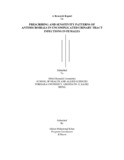Please use this identifier to cite or link to this item:
https://hdl.handle.net/20.500.14356/720| Title: | A research report on Prescribing and sensitivity patterns of antimicrobials in uncomplicated urinary tract infections in females |
| Authors: | Khan, Gulam Muhammad |
| Issue Date: | 2013 |
| Keywords: | Antimicrobials Sensitivity Prescribing Pattern Urinary Tract Infection Mid Stream Urine Pathogens |
| Abstract: | Objective: The overuse and misuse of antimicrobials have been related to growing emergence of bacterial resistance worldwide. The aim of this present study was to detect the causative agents of uncomplicated urinary tract infection in females, to assess the pattern of antimicrobial prescription along with the antimicrobial sensitivity pattern. Methodology: A prospective study was conducted in two hospitals viz. Charak Hospital and Research Centre and Western Regional Hospital, Kaski, Pokhara. Patient information was obtained by interviewing the patients and through their medical record files. Antimicrobials sensitivity testing was performed by disc diffusion. Result: A total of 175 clean catched midstream urine samples of females who were clinically diagnosed to have UTI were collected, out of which 104 (75.4%) samples grew potential pathogens causing UTI. The study showed that UTI was mostly prevalent in females of age group 20-30. Escherichia coli were the predominant (64.4%) bacterial pathogen followed by Klebsiella species (13.3%), Pseudomonas species (3.8%) and others. Most of the strains of E. coli were resistant to cephalexin whereas sensitive to cefpodoxime, amikacin, gentamycin and nitrofurantoin. Most of the urinary isolates showed high degree of resistance to cephalexin, norfloxacin nalidixic acid. Most commonly prescribed antimicrobial was ofloxacin (28.8% in Charak Hospital and Research Centre and 21.8% in Western Regional Hospital) followed by nitrofurantoin (19.2%) and azithromycin(9.6%) in hospital A and cefixime (14.9%), amoxycillin (11.9%) and azithromycin (7.9%) in hospital B. Besides, the combinations of antimicrobials were also found to be prescribed like azithromycin+cefpodoxime, azithromycin+ceftriaxone, gentamycin+azithromycin, gentamycin+ceftriaxone, ofloxacin+cefixime etc. A single antimicrobial was most commonly prescribed in both the hospitals, however, more than three antibiotics were also found to be prescribed in case of hospital B. Conclusion: This study revealed that E. coli was the predominant bacterial pathogen of uncomplicated UTIs in both hospitals. It also demonstrated an increasing resistance to cephalexin, norfloxacin and nalidixic acid. Thus, formulation of a policy for hospital antimicrobial use is most necessary to ensure safe and efficient treatment of UTIs. |
| URI: | http://103.69.126.140:8080/handle/20.500.14356/720 |
| Appears in Collections: | NHRC Research Report |
Files in This Item:
| File | Description | Size | Format | |
|---|---|---|---|---|
| 694.pdf | Full Report. Download | 549.66 kB | Adobe PDF |  View/Open |
Items in DSpace are protected by copyright, with all rights reserved, unless otherwise indicated.
